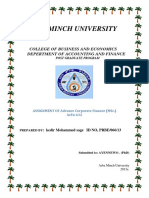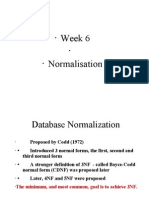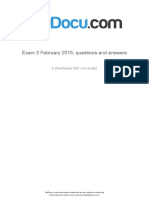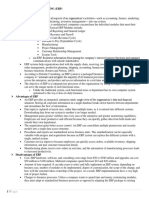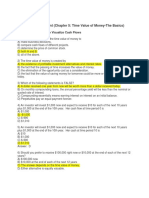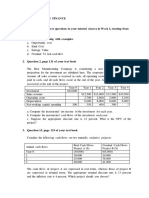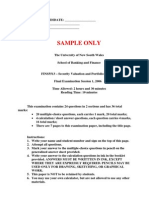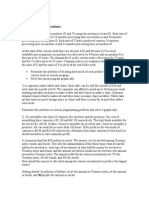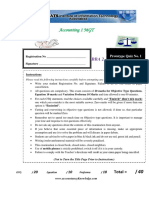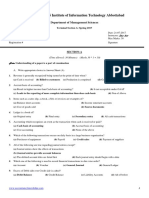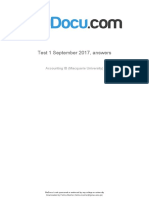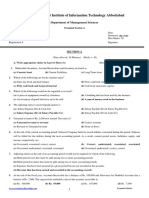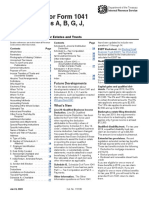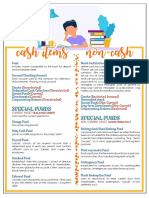Exam 2015 Questions
Exam 2015 Questions
Uploaded by
Fami FamzCopyright:
Available Formats
Exam 2015 Questions
Exam 2015 Questions
Uploaded by
Fami FamzOriginal Title
Copyright
Available Formats
Share this document
Did you find this document useful?
Is this content inappropriate?
Copyright:
Available Formats
Exam 2015 Questions
Exam 2015 Questions
Uploaded by
Fami FamzCopyright:
Available Formats
lOMoARcPSD|4041866
Exam 2015, questions
Investments and Portfolio Management (Monash University)
StuDocu is not sponsored or endorsed by any college or university
Downloaded by Fatima Mazhar (fatima.mazhar@gscwu.edu.pk)
lOMoARcPSD|4041866
OFFICE USE ONLY
Semester Two 2015
Examination Period
Faculty of Business and Economics
EXAM CODES: BFB3121
TITLE OF PAPER: INVESTMENTS AND PORTFOLIO MANAGEMENT – PAPER 1
EXAM DURATION: 3 hours writing time
READING TIME: 10 minutes
THIS PAPER IS FOR STUDENTS STUDYING AT: (tick where applicable)
Berwick Clayton Malaysia Off‐Campus Learning Open Learning
Caulfield Gippsland Peninsula Enhancement Studies Sth Africa
Parkville Other (specify)
During an exam, you must not have in your possession, a book, notes, paper, electronic device/s,
calculator, pencil case, mobile phone, smart watch/device or other material/item which has not been
authorised for the exam or specifically permitted as noted below. Any material or item on your desk,
chair or person will be deemed to be in your possession. You are reminded that possession of
unauthorised materials, or attempting to cheat or cheating in an exam is a discipline offence under Part 7 of
the Monash University (Council) Regulations.
No exam paper or other exam materials are to be removed from the room.
AUTHORISED MATERIALS
OPEN BOOK YES NO
CALCULATORS YES NO
(If YES, only calculators with an 'approved for use' Faculty label are permitted)
SPECIFICALLY PERMITTED ITEMS YES NO
If YES, items permitted are:
This paper consists of ten (10) Questions and five (5) pages of Formulae and Tables printed on a total of
thirteen (13) Pages.
Students must attempt to answer ALL questions.
Candidates must complete this section if required to write answers within this paper
STUDENT ID: __ __ __ __ __ __ __ __ DESK NUMBER: __ __ __ __ __
THIS EXAMINATION PAPER MUST BE INSERTED INTO THE ANSWER BOOK AT THE COMPLETION OF
THE PAPER.
BFB3121 Dr Abey Gunasekarage Page 1 of 13
Downloaded by Fatima Mazhar (fatima.mazhar@gscwu.edu.pk)
lOMoARcPSD|4041866
OFFICE USE ONLY
BFB3121 INVESTMENTS AND PORTFOLIO MANAGEMENT
Question 1: Financial Instruments & Markets
(a) Compare and contrast features of preferred stock to corporate bonds giving at
least two similarities and two differences.
(3 marks)
(b) You are provided with the price information for the following four stocks:
Stock Price ($) Price ($)
(t=0) (t=1)
A 80 110
B 100 90
C 50 60
D 70 80
Calculate the following:
(i) Price weighted index at t=0 and t=1.
(ii) Return on the price weighted index for the period.
(iii) Return on an equally weighted index.
(5 marks)
(c) Give an example of a broad based index used to track Australian shares.
(2 marks)
(Total 10 Marks)
Question 2: Trading Mechanism; Mutual Funds & Investment Companies
(a) Given below is some price information on Estelle stock at 11am today. Suppose the
stock is traded in a dealer market.
Bid Ask
50.25 50.50
(i) Sam has submitted an order to his broker to buy at market. At what price will
Sam’s trade be executed?
(ii) Clair has submitted an order to her broker to sell at market. At what price will
Clair’s trade be executed?
(iii) John has submitted a limit order to his broker to sell at $50.62. Will John’s trade
be executed? Explain why.
(iv) Jan has submitted a limit order to her broker to buy at $ 50.37. Will Jan’s trade be
executed? Explain why.
(4 marks)
(Cont’d on next page)
BFB3121 Dr Abey Gunasekarage Page 2 of 13
Downloaded by Fatima Mazhar (fatima.mazhar@gscwu.edu.pk)
lOMoARcPSD|4041866
OFFICE USE ONLY
BFB3121 INVESTMENTS AND PORTFOLIO MANAGEMENT
Question 2 (cont’d)
(b) Ace Trader opens a brokerage account and purchases 500 shares of Internet Plays at
$50 per share. She borrows $10,000 from her broker to finance the purchase. The
interest rate on the loan is 8% p.a. The maintenance margin is 30%.
(i) What is the initial margin of Ace’s account?
(ii) How far does the price of stock have to fall by the end of the year for Ace to receive
a margin call?
(iii) If the share price falls to $35 at the end of the year, what is the remaining margin
in her account?
(iv) What is the rate of return earned by Ace on her investment?
(6 marks)
(Total 10 Marks)
Question 3: Risk & Return; Risk Aversion & Capital Allocation
(a) Assume that you bought a zero‐coupon bond with a face value of $1,000 for $870 five
years ago. The bond matures today.
(i) What is your 5‐year holding period return [r(5)]?
(ii) What is your effective annual rate of return?
(iii) If the average annual rate of inflation has been 2% over the last five years, what
is your exact annual real rate of return?
(3 marks)
(b) Your uncle invested $200,000 in a portfolio of securities 10 years ago. The value of this
portfolio investment today is $350,000. The average treasury bill rate for the same
period is 2.7% per annum.
Calculate the risk premium earned by your uncle’s investment.
(3 marks)
(c) Your client, Jo Bernard, holds a complete portfolio that consists of a portfolio of risky
assets (P) and treasury bills (T‐Bills). The information below refers to these assets.
12% p.a.
7.20% p.a.
T‐Bill rate 3.60% p.a.
Proportion of complete portfolio in P 80%
Proportion of complete portfolio in T‐Bills 20%
BFB3121 Dr Abey Gunasekarage Page 3 of 13
Downloaded by Fatima Mazhar (fatima.mazhar@gscwu.edu.pk)
lOMoARcPSD|4041866
OFFICE USE ONLY
BFB3121 INVESTMENTS AND PORTFOLIO MANAGEMENT
Question 3 (cont’d)
(i) What is the expected return on Jo Bernard 's complete portfolio?
(ii) What is the standard deviation of Jo Bernard 's complete portfolio?
(iii) What is the equation of Jo Bernard 's Capital Allocation Line?
(4 marks)
(Total 10 Marks)
Question 4: Optimal Risky Portfolios; Index Models
(a) The manager of a superannuation scheme is planning to create a portfolio by investing
in the following equity and bond funds:
Fund type
Equity Fund 18% 26%
Bond Fund 8% 12%
The returns of these two funds have a correlation coefficient of 0.15. The manager
wants to invest in the portfolio with the minimum variance.
(i) Calculate the proportions (i.e. weights) that the manager should invest in each
fund to achieve the minimum variance portfolio.
(ii) What are the expected return and standard deviation of the minimum variance
portfolio?
(iii) Assume that the manager wants an expected return of 11% per annum from his
portfolio. What advice would you give to him?
(6 marks)
(b) The estimation of the index model for share “Neem’ resulted in the following equation:
R N 0.02 0.97 RM e N
[Note: RN (rN r f ) and RM (rM r f ) ]
The R2 of the model is 0.45. The standard deviation of the market portfolio ( M ) is 0.30.
(i) What is the standard deviation of share ‘Neem’?
(ii) What is the firm‐specific risk of this share?
(4 marks)
(Total 10 Marks)
BFB3121 Dr Abey Gunasekarage Page 4 of 13
Downloaded by Fatima Mazhar (fatima.mazhar@gscwu.edu.pk)
lOMoARcPSD|4041866
OFFICE USE ONLY
BFB3121 INVESTMENTS AND PORTFOLIO MANAGEMENT
Question 5: CAPM
(a) Discuss the differences between the capital market line and the security market line.
(3 marks)
(b) You work for an investment company and your supervisor has asked you to
recommend the best securities selector among the following fund managers:
Fund Manager Portfolio Beta Average annual return
1 1.00 15%
2 1.20 20%
3 0.80 16%
4 1.25 22%
Assume that the risk free rate (rf) is 3% per annum and the expected return on the
market portfolio is 15% per annum.
Provide necessary calculations and determine which fund manager was the best
securities selector.
(5 marks)
(c) You have invested in a well‐diversified portfolio of Australian equities. Your portfolio
beta is 1.40. The financial press predicts that the Australian equity market would have
a bearish run over the forthcoming month.
Explain how you would rebalance your equity portfolio in order to overcome any
adverse impacts.
(2 marks)
(Total 10 Marks)
Question 6: Market Efficiency & Behavioural Finance
(a) What is an efficient market? What is the implication of an efficient market?
(2 marks)
(b) Determine whether the following situations are consistent or inconsistent with the
efficient market hypothesis:
(i) You observe that when the current stock prices of companies are above (below)
their long run moving averages, they tend to show upward (downward) trends
for the following few days.
(ii) Stock prices that have risen (fallen) in the past few weeks, tend to rise (fall) in the
forthcoming few weeks.
(2 marks)
(cont’d on next page)
BFB3121 Dr Abey Gunasekarage Page 5 of 13
Downloaded by Fatima Mazhar (fatima.mazhar@gscwu.edu.pk)
lOMoARcPSD|4041866
OFFICE USE ONLY
BFB3121 INVESTMENTS AND PORTFOLIO MANAGEMENT
Question 6 (cont’d)
(c) If you identify any of the scenarios in (b) above as inconsistent, explain how you use
such scenarios to earn abnormal return.
(2 marks)
(d) ‘Behavioral finance posits that investors possess behavioral biases’.
Discuss the importance of behavioral biases and explain the four behavioral biases
identified in the literature.
(4 marks)
(Total 10 Marks)
Question 7: Bond Prices & Yields; Bond Portfolio Management
(a) Explain the relationships between (i) price and face value and (ii) yield and coupon rate
in each of a par, discount and premium bond.
(3 marks)
(b) A 20‐year maturity bond with a par value of $1,000 makes semi‐annual coupon
payments at an annual coupon rate of 8%. This bond is currently selling at $1,050.
Calculate the bond equivalent and the effective annual yield to maturity for this bond.
(3 marks)
(c) An insurance company must make payments to a customer of $8 million in 1 year and
$5 million in 5 years. The yield curve is flat at 10% per annum.
(i) If the insurance company wants to fully fund and immunize its obligation to this
customer with a single issue of a zero‐coupon bond, what maturity bond should
it purchase?
(ii) What must be the face value and market value of the bond?
(4 marks)
(Total 10 Marks)
BFB3121 Dr Abey Gunasekarage Page 6 of 13
Downloaded by Fatima Mazhar (fatima.mazhar@gscwu.edu.pk)
lOMoARcPSD|4041866
OFFICE USE ONLY
BFB3121 INVESTMENTS AND PORTFOLIO MANAGEMENT
Question 8: Equity Valuation
Instell Ltd reported an EPS of $24 for the just concluded financial year and paid a dividend
per share of $9.60. The company’s return on equity (ROE) is 15% per annum.
The company’s book value per share is $120 while its current share price is $95.
The analysts believe that Instell’s current growth rate will last for another three years.
However, the growth rate will drop to the industry average of 5% in year four and will remain
at that level forever.
The company’s required rate of return is 16% per annum.
(a) Calculate the intrinsic value of Instell shares.
(6 marks)
(b) If the market‐to‐book value for the market is 1.25, calculate the market‐to‐book value
of Instell relative to the market.
(2 marks)
(c) Would you consider Instell shares as a good buy?
(2 marks)
(Total 10 Marks)
Question 9: Options Markets; Option Valuation
(a) Differentiate between American options and European options.
(2 marks)
(b) You purchased a call option for $3.45 seventeen days ago. The call has a strike price of
$45 and the stock is now trading for $51. If you exercise the call today, what will be
your holding period return?
(2 marks)
(c) Using the Black‐Scholes option pricing model, estimate the value of the following call
option:
S0 = $100; X = $95; r = 0.10; T =0.25 (3 months); σ = 0.50
(6 marks)
(Total 10 Marks)
BFB3121 Dr Abey Gunasekarage Page 7 of 13
Downloaded by Fatima Mazhar (fatima.mazhar@gscwu.edu.pk)
lOMoARcPSD|4041866
OFFICE USE ONLY
BFB3121 INVESTMENTS AND PORTFOLIO MANAGEMENT
Question 10: Portfolio Performance Evaluation; International Diversification
(a) The following data are available relating to the performance of Sooner Stock and the
market portfolio:
Variable Sooner Stock Market Portfolio
Average return 20% 11%
Standard deviation of return 44% 19%
Beta 1.8 1.0
Residual standard deviation 2.0% 0.0%
The risk‐free return during the sample period is 3% per annum.
(i) What are the Sharpe, Treynor, Jensen and information ratio measures of
performance evaluation for Sooner Stock?
(ii) Which of the above performance measures is relevant to you if Sooner is the only
security you have invested in? Why?
(iii) Which of the above performance measures is relevant to you if Sooner is only one
stock among many stocks in your investment portfolio? Why?
(5 marks)
(b) You are an Australian investor who purchased British securities for £4,000 one year
ago when the British pound cost AU$1.25. You received a dividend income of £200 at
the end of the year. The value of the securities is now £5,400 and the pound is worth
AU$1.40. What is your Australian dollar denominated total return?
(2.5 marks)
(c) Explain why the benefits of international diversification may not be preserved during
a period of global financial crisis.
(2.5 marks)
(Total 10 Marks)
END OF EXAMINATION
BFB3121 Dr Abey Gunasekarage Page 8 of 13
Downloaded by Fatima Mazhar (fatima.mazhar@gscwu.edu.pk)
lOMoARcPSD|4041866
OFFICE USE ONLY
BFB3121 INVESTMENTS AND PORTFOLIO MANAGEMENT
Formulae
1
R(1 t ) i (r i)(1 t ) i r (1 t ) it
Market Value of Assets Liabilities
NAV
Shares Outs tan ding
EAR 1 rf (T ) T 1
1
P1 P0 D1
r
P0
1
N
g P N 1
P 0
E (rP ) rf
E (rC ) rf C
P
E (rC ) rf y E (rP ) rf
E (rP ) r f
S
P
Cov ( Ri , R j ) i j M2
C y P
22 Cov (r1 , r2 )
W1
12 22 2Cov(r1 , r2 )
[ E (rS ) rf ] B2 [ E (rB ) rf ] Cov(rS , rB )
wS
[ E (rS ) rf ] B2 [ E (rB ) rf ] S2 [ E (rS ) rf E (rB ) rf ] Cov(rS , rB )
P2 (W12 )( 12 ) (W22 )( 22 ) 2(W1 )(W2 )Cov (r1 , r2 )
Cov(r1, r2 ) 1, 2 1 2
E (ri ) rf i [ E (rm ) rf ]
sn
E (r ) p
s 1
s rs
sn 2
2
( p s ) r s E ( r s )
s 1
U E (r ) 0.5( A)( 2 )
BFB3121 Dr Abey Gunasekarage Page 9 of 13
Downloaded by Fatima Mazhar (fatima.mazhar@gscwu.edu.pk)
lOMoARcPSD|4041866
OFFICE USE ONLY
BFB3121 INVESTMENTS AND PORTFOLIO MANAGEMENT
i n
E (rP ) Wi E (ri )
i 1
2 (eP ) wA2 2 (eA ) wB2 2 (eB ) w2f 2 (e f )
2 m2
R2
i2
Ri ,t i i RM ,t ei ,t
i2 2 m2 2 (ei )
P2 P2 M2 2 (e p )
n
P Wi i
i 1
E
WD
D E
E(rP ) rf
y*
A( P2 )
PB Ct T ParValue
T
T
t 1 (1 r ) (1 r )
T
Do(1 g )
Po
kg
g ROE b
T
D t w t
t 1
wt CF t (1 y ) Price
t
Volume declining
Number declining
Trin =
Volume advancing
Number advancing
D D1 2
... D P
N N
P
(1 k ) (1 k ) (1 k )
0 1 2 N
BFB3121 Dr Abey Gunasekarage Page 10 of 13
Downloaded by Fatima Mazhar (fatima.mazhar@gscwu.edu.pk)
lOMoARcPSD|4041866
OFFICE USE ONLY
BFB3121 INVESTMENTS AND PORTFOLIO MANAGEMENT
FCFF EBIT (1 t c ) DEP CAPEX Increase in WC
P (1 y )
D
P (1 y )
D
D*
(1 y )
1 y (1 y ) T (c y )
D
y c[(1 y )T 1] y
E1
P0 PVGO
k
P0 1
E1 k
P
D * y
P
D1 E1(1 b)
P0
k g k (b ROE )
P0 1 b
E1 k (b ROE )
P
D * (y ) 1 (Convexity)(y ) 2
P
2
D
Po
k
Dt
Po
(1 k ) t
t 1
Cu Cd
H
uS 0 dS 0
S 2
ln 0 r T
X 2
d1
T
d 2 d1 T
C0 S 0 N (d1 ) Xe rT N (d 2 )
X
C P S0
(1 r f ) T
BFB3121 Dr Abey Gunasekarage Page 11 of 13
Downloaded by Fatima Mazhar (fatima.mazhar@gscwu.edu.pk)
lOMoARcPSD|4041866
OFFICE USE ONLY
BFB3121 INVESTMENTS AND PORTFOLIO MANAGEMENT
(1 rG ) n (1 r1 )(1 r2 )...(1 rn )
C C C
PV r p 1 1 r f 2 2 ... n n
? 1 r 1
r 1 r
P
rp rf
?
P
P
?
(e P )
P r P r f P (r m r f )
n n
r r w r w r i 1
pi pi
p B
i 1
Bi Bi
ARi ,t Ri ,t [ R f ,t i ( Rm,t R f ,t )]
? (WPi WBi )rBi
? (rPi rBi )WPi
ARi ,t Ri ,t [ i i ( Rm,t )]
BFB3121 Dr Abey Gunasekarage Page 12 of 13
Downloaded by Fatima Mazhar (fatima.mazhar@gscwu.edu.pk)
lOMoARcPSD|4041866
OFFICE USE ONLY
BFB3121 INVESTMENTS AND PORTFOLIO MANAGEMENT
BFB3121 Dr Abey Gunasekarage Page 13 of 13
Downloaded by Fatima Mazhar (fatima.mazhar@gscwu.edu.pk)
You might also like
- Sample Secretary's CertificateDocument1 pageSample Secretary's Certificatechevroliem60% (5)
- Case 5 Chrysler ExamDocument6 pagesCase 5 Chrysler ExamFami FamzNo ratings yet
- ENGM115+Assignment+1+of+1 2020 21Document8 pagesENGM115+Assignment+1+of+1 2020 21Mahnoor RehmanNo ratings yet
- 26 Questions On Finance Answered 2Document10 pages26 Questions On Finance Answered 2208322 Popoola Ibrahim INDUSTRIALNo ratings yet
- Demand Letter Monthly Association DuesDocument1 pageDemand Letter Monthly Association DuesConcepcion Cejano80% (5)
- Accounting Cheat SheetDocument2 pagesAccounting Cheat Sheetanoushes1100% (2)
- Chapter 6 Valuation and Characteristics of BondsDocument30 pagesChapter 6 Valuation and Characteristics of BondsKiran AishaNo ratings yet
- When Goods Are Purchased:: Journal Entries in A Perpetual Inventory SystemDocument27 pagesWhen Goods Are Purchased:: Journal Entries in A Perpetual Inventory SystemFami FamzNo ratings yet
- Practice Exam Spring 2018 Questions and AnswersDocument3 pagesPractice Exam Spring 2018 Questions and AnswersFami FamzNo ratings yet
- Group Assignment - Financial AnalysisDocument4 pagesGroup Assignment - Financial AnalysisAN THÁI THỊ THANHNo ratings yet
- Individual AssignmentDocument8 pagesIndividual AssignmentpradeepNo ratings yet
- Corporate Answer 13 Ledt PDFDocument11 pagesCorporate Answer 13 Ledt PDFHope KnockNo ratings yet
- Q&aDocument70 pagesQ&apaulosejgNo ratings yet
- Assignment International BusinessDocument2 pagesAssignment International BusinessAbood .M100% (1)
- Tutorial-2 212 Mba 680 SolutionsDocument9 pagesTutorial-2 212 Mba 680 SolutionsbillyNo ratings yet
- Lecture On Data Collection MethodDocument31 pagesLecture On Data Collection MethodPRITI DASNo ratings yet
- Fm202 Exam Questions 2013Document12 pagesFm202 Exam Questions 2013Grace VersoniNo ratings yet
- Solutions To Chapter 5 Valuing BondsDocument8 pagesSolutions To Chapter 5 Valuing BondsCandace WagnerNo ratings yet
- Sample Exam Questions (And Answers)Document22 pagesSample Exam Questions (And Answers)Diem Hang VuNo ratings yet
- ProblemsDocument4 pagesProblemsKritika SrivastavaNo ratings yet
- Class 1 Investments BKM Chapter9Document19 pagesClass 1 Investments BKM Chapter9Daniel PortellaNo ratings yet
- NormalisationDocument18 pagesNormalisationrahul0% (1)
- Dull-Gelinas Chapter 4Document41 pagesDull-Gelinas Chapter 4Richard Dan Ilao ReyesNo ratings yet
- Revision Pack 4 May 2011Document27 pagesRevision Pack 4 May 2011Lim Hui SinNo ratings yet
- Lecture On Database NormalisationDocument31 pagesLecture On Database NormalisationbachibNo ratings yet
- Financial Econometrics-Mba 451F Cia - 1 Building Research ProposalDocument4 pagesFinancial Econometrics-Mba 451F Cia - 1 Building Research ProposalPratik ChourasiaNo ratings yet
- Tutorial Workbook 2019Document48 pagesTutorial Workbook 2019KriswantoNo ratings yet
- Week 5 - Feasibility StudyDocument21 pagesWeek 5 - Feasibility StudyEskinderNo ratings yet
- Exam 3 February 2015, Questions and Answers Exam 3 February 2015, Questions and AnswersDocument15 pagesExam 3 February 2015, Questions and Answers Exam 3 February 2015, Questions and Answersben yiNo ratings yet
- Arbitrage Pricing Theory: Prof Mahesh Kumar Amity Business SchoolDocument28 pagesArbitrage Pricing Theory: Prof Mahesh Kumar Amity Business SchoolasifanisNo ratings yet
- Financial ModelingDocument16 pagesFinancial ModelingNidhy KhajuriaNo ratings yet
- 3-Project Failure and SuccessDocument28 pages3-Project Failure and SuccessKirolos MouriceNo ratings yet
- Session 1 Intro To Systems Thinking Presentation FV PDFDocument61 pagesSession 1 Intro To Systems Thinking Presentation FV PDFPratiksha GoreNo ratings yet
- Capital Budgeting AnswerDocument18 pagesCapital Budgeting AnswerPiyush ChughNo ratings yet
- Sharpe Treynor N JensenDocument4 pagesSharpe Treynor N JensenjustsatyaNo ratings yet
- Management Control SystemsDocument50 pagesManagement Control SystemsMapuia Lal PachuauNo ratings yet
- Lesson 7 Capital Asset Pricing Model and Modern Porfolio TheoryDocument10 pagesLesson 7 Capital Asset Pricing Model and Modern Porfolio Theoryman ibeNo ratings yet
- Enterprise Resource PlanningDocument11 pagesEnterprise Resource Planningjudel ArielNo ratings yet
- Practice Questions On Time Value of MoneyDocument7 pagesPractice Questions On Time Value of MoneyShashank shekhar ShuklaNo ratings yet
- Portfolio Performance EvaluationDocument28 pagesPortfolio Performance Evaluationleolau2015No ratings yet
- CH 05Document11 pagesCH 05kmarisseeNo ratings yet
- Or SimulationDocument25 pagesOr SimulationBalaji Ganesh100% (1)
- A Capacity Planning Assignment 2016 Bassam Senior Modified SolutionDocument10 pagesA Capacity Planning Assignment 2016 Bassam Senior Modified SolutionAhmad Ayman FaroukNo ratings yet
- Ratio Analysis Assignment 2020Document1 pageRatio Analysis Assignment 2020Nguyễn Thu TrangNo ratings yet
- Financial Modelling Exam PaperDocument1 pageFinancial Modelling Exam PapersmartpepNo ratings yet
- Chapter 9 - Multifactor Models of Risk & ReturnDocument10 pagesChapter 9 - Multifactor Models of Risk & ReturnImejah FaviNo ratings yet
- Assignment 1Document2 pagesAssignment 1Elston DsouzaNo ratings yet
- Tailieumienphi - VN Lecture Logistics Theory Lecture 16 Material Requirements PlanningDocument21 pagesTailieumienphi - VN Lecture Logistics Theory Lecture 16 Material Requirements PlanningBong ThoNo ratings yet
- Tutorial 02 QuestionsDocument2 pagesTutorial 02 QuestionsAamir ShaikNo ratings yet
- Estimating IRR With Fake Payback Period-L10Document9 pagesEstimating IRR With Fake Payback Period-L10akshit_vij0% (1)
- Tutorial Set 7 - SolutionsDocument5 pagesTutorial Set 7 - SolutionsChan Chun YeenNo ratings yet
- FINS5513 Security Valuation and Portfolio Selection Sample ExamDocument8 pagesFINS5513 Security Valuation and Portfolio Selection Sample Examoniiizuka100% (1)
- IplDocument13 pagesIplintisarNo ratings yet
- Solved Examples Based On Ebit-Eps Analysis - Part 1 Example Help For Leverage, Management, Homework Help - Transtutors - ComDocument3 pagesSolved Examples Based On Ebit-Eps Analysis - Part 1 Example Help For Leverage, Management, Homework Help - Transtutors - Communish12345650% (2)
- Dividend PolicyDocument44 pagesDividend PolicyRipudaman BhatnagarNo ratings yet
- Paper 14 SolutionDocument23 pagesPaper 14 SolutionNisarg JoshiNo ratings yet
- Project Introduction: Chinook DatabaseDocument42 pagesProject Introduction: Chinook DatabaseFiveer FreelancerNo ratings yet
- Answer FIN 401 Exam2 Fall15 V1Document7 pagesAnswer FIN 401 Exam2 Fall15 V1mahmudNo ratings yet
- Assignment On Data CollectionDocument5 pagesAssignment On Data CollectionTilak KarmakarNo ratings yet
- Cost Assignment (Cost Allocation)Document28 pagesCost Assignment (Cost Allocation)Lee Li HengNo ratings yet
- Finance Practice File 1 With SolutionsDocument18 pagesFinance Practice File 1 With Solutionsdscgool1232100% (2)
- 3 Inventory Management and Risk PoolingDocument60 pages3 Inventory Management and Risk PoolingpranavsharadNo ratings yet
- Linear Programming ExamplesDocument7 pagesLinear Programming ExamplesgoforjessicaNo ratings yet
- Value Chain Management Capability A Complete Guide - 2020 EditionFrom EverandValue Chain Management Capability A Complete Guide - 2020 EditionNo ratings yet
- Registration No: Q1. Multiple Choice Questions (Marks 10)Document4 pagesRegistration No: Q1. Multiple Choice Questions (Marks 10)Fami FamzNo ratings yet
- Plant Asset QuizDocument3 pagesPlant Asset QuizFami Famz100% (3)
- Quiz 1 Sample 7 SolvedDocument6 pagesQuiz 1 Sample 7 SolvedFami FamzNo ratings yet
- Sample/practice Exam 13 November 2015, Questions Sample/practice Exam 13 November 2015, QuestionsDocument19 pagesSample/practice Exam 13 November 2015, Questions Sample/practice Exam 13 November 2015, QuestionsFami FamzNo ratings yet
- Accounting 1 MGT: Registration No - SignatureDocument6 pagesAccounting 1 MGT: Registration No - SignatureFami FamzNo ratings yet
- Sessional 2 Paper Sample 2Document3 pagesSessional 2 Paper Sample 2Fami FamzNo ratings yet
- Quiz 1 Sample 3 SolutionDocument6 pagesQuiz 1 Sample 3 SolutionFami FamzNo ratings yet
- Sessional 2 Paper Sample 3Document3 pagesSessional 2 Paper Sample 3Fami FamzNo ratings yet
- Terminal Sample 2 SolvedDocument11 pagesTerminal Sample 2 SolvedFami FamzNo ratings yet
- Test 1 September 2017, Answers Test 1 September 2017, AnswersDocument7 pagesTest 1 September 2017, Answers Test 1 September 2017, AnswersFami FamzNo ratings yet
- Sessional 2 Paper Sample 1Document3 pagesSessional 2 Paper Sample 1Fami FamzNo ratings yet
- Sessional 2 Solved Sample 3Document4 pagesSessional 2 Solved Sample 3Fami FamzNo ratings yet
- Prepare: Cash and Signs A Note For The BalanceDocument1 pagePrepare: Cash and Signs A Note For The BalanceFami FamzNo ratings yet
- Sessional 1 Unsolved Sample 1Document4 pagesSessional 1 Unsolved Sample 1Fami FamzNo ratings yet
- Terminal Sample 1 UnsolvedDocument9 pagesTerminal Sample 1 UnsolvedFami FamzNo ratings yet
- Terminal Sample 1 SolvedDocument14 pagesTerminal Sample 1 SolvedFami FamzNo ratings yet
- Terminal Sample 2 UnsolvedDocument7 pagesTerminal Sample 2 UnsolvedFami FamzNo ratings yet
- Partnership - TheoriesDocument1 pagePartnership - TheoriesBrian Christian VillaluzNo ratings yet
- HDFC - Customer RelationshipDocument77 pagesHDFC - Customer Relationshipvinaykrissh68% (25)
- Accounts Project JK TyreDocument16 pagesAccounts Project JK Tyresj tjNo ratings yet
- Project Report For Land ApprovalDocument12 pagesProject Report For Land ApprovalSrihari BabuNo ratings yet
- Cpareviewschoolofthephilippines ChanchanDocument8 pagesCpareviewschoolofthephilippines ChanchanDavid David100% (1)
- Deed of HypothecationDocument2 pagesDeed of HypothecationJay Evans100% (1)
- Examination: Subject CA1 Core Applications Concepts Paper 1 (Assets)Document13 pagesExamination: Subject CA1 Core Applications Concepts Paper 1 (Assets)Saad MalikNo ratings yet
- Financial ManagementDocument16 pagesFinancial ManagementDijen ChingNo ratings yet
- G.R. No. 221218: Digested By: Daniel HuligangaDocument14 pagesG.R. No. 221218: Digested By: Daniel HuligangaJohn Paul Dumaguin CastroNo ratings yet
- Amit Wadhwaney PresentationDocument9 pagesAmit Wadhwaney PresentationBiren PatelNo ratings yet
- Quizlet Test Dividend PDFDocument3 pagesQuizlet Test Dividend PDFAPRATIM BHUIYANNo ratings yet
- Instructions For Form 1041 and Schedules A, B, G, J, and K-1Document50 pagesInstructions For Form 1041 and Schedules A, B, G, J, and K-1SeniorNo ratings yet
- 2nd Battalion 150th Field Artillery Retention Newsletter: Soldiers in Six Month ETS WindowDocument4 pages2nd Battalion 150th Field Artillery Retention Newsletter: Soldiers in Six Month ETS WindowoperationemploymentNo ratings yet
- MBA Notes For Insurance Risk ManagementDocument14 pagesMBA Notes For Insurance Risk ManagementSudhanshu Sharma100% (3)
- Accounting Problems of Islamic BanksDocument27 pagesAccounting Problems of Islamic Banksaqas_khan100% (1)
- Cash and Cash EquivalentsDocument3 pagesCash and Cash EquivalentsRheea de los SantosNo ratings yet
- National Social Assistance Program (Nsap)Document16 pagesNational Social Assistance Program (Nsap)kanik09100% (1)
- Part A: PersonalDocument2 pagesPart A: Personalpravallika vysyarajuNo ratings yet
- Change of Option Form 2020Document3 pagesChange of Option Form 2020Charles MutetwaNo ratings yet
- Chapter 3Document18 pagesChapter 3Malabaris Malaya Umar SiddiqNo ratings yet
- Madrigal V RaffertyDocument2 pagesMadrigal V RaffertyiptrinidadNo ratings yet
- Assignment of Management of Working Capital On Chore CommitteeDocument4 pagesAssignment of Management of Working Capital On Chore CommitteeShubhamNo ratings yet
- EMB 501 Assignment Submission - 1Document13 pagesEMB 501 Assignment Submission - 1tasnuba sinhaNo ratings yet
- Form Accepted Federal 2019 PDFDocument10 pagesForm Accepted Federal 2019 PDFRandy PettersonNo ratings yet
- Fort Bonifacio Dev Corp Vs CirDocument191 pagesFort Bonifacio Dev Corp Vs Circaren kay b. adolfoNo ratings yet
- Givling Queue Point OffersDocument34 pagesGivling Queue Point OffersjohnNo ratings yet
- 50CENT Bankruptcy DocumentDocument22 pages50CENT Bankruptcy DocumentThe Verge100% (1)











